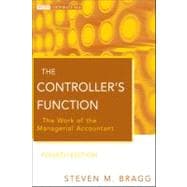
Note: Supplemental materials are not guaranteed with Rental or Used book purchases.
Purchase Benefits
What is included with this book?
Chapter 1: The Controller's Job.
Main Job Functions.
Job Description.
Job Qualifications.
Organizational Structure of the Accounting Department.
Ethics.
Chapter 2: Internal Control.
Basic Elements.
Controls to Use in Your Business.
Elements of Internal Accounting Control.
Levels of Controls.
Fraud.
Auditing for Fraud.
Notes.
Chapter 3: Planning and the Strategic Plan.
Strategic Plan Overview.
System of Plans.
Planning Cycle.
Planning Roles.
Planning Timing and the Planning Period.
Business Mission.
Developing Long-Range Objectives.
Developing Long-Range Strategies.
Chapter 4: Long-Range Financial Plan.
Layout and Purpose.
Trends of Revenues and Profits.
Capital Investments.
Cash Flows and Financing Requirements.
Risk Analysis.
Breakdown by Business Unit/Product Line/Geography.
Financial Position.
Chapter 5: Annual Plan.
System of Plans.
Additional Budget Modeling Topics.
Annual Planning Cycle.
Role of the Controller.
Sales Planning: The Base of All Business Plans.
Steps in Developing the Near-Term Sales Plan.
Methods for Determining the Sales Forecast.
Changes in the Sales Mixture.
Changes in the Sales Price.
Changes in the Cost.
Chapter 6: Sales.
Role of the Controller.
Sales Analysis.
Sales Standards.
Sales Reports.
Product Pricing.
Chapter 7: Distribution Expenses.
Role of the Sales Manager.
Analyzing Distribution Costs.
Analyzing by Application.
Setting the Distribution Budget.
Chapter 8: Direct Materials and Labor.
Objectives.
Role of the Controller.
Types of Cost Systems.
Measuring Direct Material Costs.
Controlling Direct Material Costs.
Controlling Direct Material Quantities.
Measuring Direct Labor Costs.
Controlling Direct Labor Costs.
Target Costing.
Chapter 9: Overhead.
Need for Overhead Controls.
Responsibilities of the Controller.
Account Classifications.
Fixed and Variable Costs.
Cost Allocation.
Controlling Overhead.
Production Reports.
Chapter 10: General and Administrative Expenses.
Functions Involved.
Accounting for and Allocating Administrative Expenses.
Responsibility Accounting.
"Unique" Expenses.
Controlling Costs.
Chapter 11: Cash and Investments.
Objectives of Cash Management.
Role of the Controller.
Cash Collections.
Cash Disbursements.
Investment of Short-Term Funds.
Accounting for Records of Investment.
Cash and Investment Controls.
Chapter 12: Receivables.
Functions of the Credit Department.
Shortening the Receivables Cycle.
Reserve for Doubtful Accounts.
Receivables Fraud and Control.
Chapter 13: Inventory.
Inventory Management Systems.
Inventory Tracking.
Physical Inventory Procedure.
Inventory Valuation.
Inventory Fraud and Controls.
Chapter 14: Property, Plant, and Equipment.
Role of the Controller.
Capital Budgeting.
Postproject Appraisals.
Other Aspects of Fixed Assets.
Chapter 15: Liabilities.
Objectives.
Controls.
Credit Agreement Provisions.
Debt Capacity.
Bond Ratings.
Leverage.
Chapter 16: Equity.
Role of the Controller.
Cost of Capital.
Dividend Policy.
Long-Term Equity Planning.
Repurchasing Common Shares.
Capital Stock Records.
Chapter 17: Operational Accounting.
Create Departmental Job Descriptions.
Create a Departmental Training Program.
Clear Out Excess Documentation.
Streamline the Accounting Workflow.
Document All Major Processes.
Schedule the Department.
Correct the Underlying Causes of Errors.
Use of Best Practices.
Outsourcing Selected Accounting Functions.
Chapter 18: The Fast Close.
Different Types of Fast Close.
How to Achieve a Fast Close.
Enhanced Closing Process.
Summary.
Chapter 19: SEC Filings.
Form 8-K.
Annual 10-K and Quarterly 10-Q Reports.
Timing of Annual and Quarterly Report Filings.
Form S-1.
Form S-3.
Form S-8.
Forms Requiring Payment to the SEC.
Fedwire Payments.
Chapter 20: Performance Measurements and Trends.
Performance Measurements.
Trends.
Interrelationship of Ratios.
Just-in-Time Ratios.
Chapter 21: Financial Analysis.
Analyzing Financial Statements.
Analyzing Working Capital.
Analyzing Financing Options.
Services Profitability Analysis.
The Throughput Analysis Model.
Production Outsourcing Decision.
New Product Decision.
Chapter 22: Cost Reduction.
Types of Reports Used for Cost Reduction Analysis.
Spend Analysis Overview.
Spend Database.
Supplier Consolidation Analysis.
Parts Consolidation Analysis.
Maintenance, Repair, and Operations Item Analysis.
Spend Compliance.
Spend Analysis Reports.
Workforce Reduction Analysis.
Workforce Reduction Issues.
Workforce Reduction Alternatives.
5S Analysis.
Check Sheets.
Error Quantification.
Fixed Cost Analysis.
Ishikawa Diagrams.
Value Stream Mapping.
Waste Analysis.
Chapter 23: Taxes.
Tax Strategy.
Tax Organization.
Role of the Tax Manager.
Tax Records.
Tax versus Book Accounting.
Sales and Use Taxes.
Proper Classification of Accounts.
Chapter 24: Selecting a Financial Information System.
Reasons to Purchase Software.
Defining Systems Requirements.
Existing System Documentation.
Joint Sessions.
Preparing the Request for Proposal.
Distribution of the Request for Proposal.
Review of the Vendor's Completed Proposal.
Reference Calls.
Demonstration.
Site Visits.
Cost of the System.
Final Selection.
Contract Negotiations.
Postimplementation Review.
Appendix New Controller Checklist.
About the Author.
Index.
The New copy of this book will include any supplemental materials advertised. Please check the title of the book to determine if it should include any access cards, study guides, lab manuals, CDs, etc.
The Used, Rental and eBook copies of this book are not guaranteed to include any supplemental materials. Typically, only the book itself is included. This is true even if the title states it includes any access cards, study guides, lab manuals, CDs, etc.